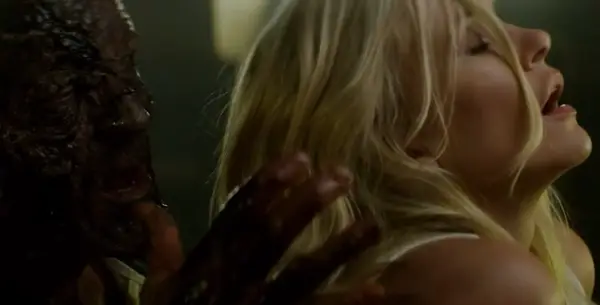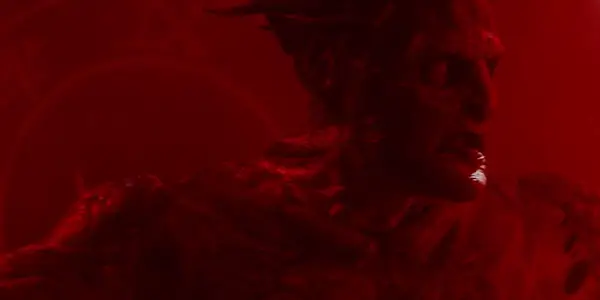THE BLACK ROOM: Horrifying For All The Wrong Reasons

Chris is a B.A.H. graduate with a concentration in pre-19th…
Horror can be smart; this isn’t something new we’re learning from It Follows or Get Out, rather something to which the industry and new audiences are finally being exposed to. However, horror, like any genre, can be unbelievably stupid at times, too. This is the case of The Black Room.
Whereas a film like 1982’s The Entity – starring Barbara Hershey as a woman under siege by a poltergeist who sexually assaults her – uses eroticism in an unsettling way, The Black Room feels more intent on being trashy than a worthwhile examination of a haunting. Instead, the audience is treated to a softcore pornographic movie crossed with a yawn inducing, typical haunted house romp.
Although the movie boasts a couple well-executed makeup effects early on, the remainder is as bland as an unseasoned meal and without any semblance of style. For an hour and a half the characters are largely unlikable, the plot a meandering jumble of blood and demonic possession, as well as the fact the sex scenes are disgusting. Perhaps most disappointing is the acting talent of Lin Shaye, usually a welcomed presence in any genre picture, totally wasted on horror with no heart or soul, and not an inch of character development.
Skin For the Sake of Skin
Right from the first scene there’s nudity, and Shaye gets tossed into the mix, which makes for awkward results. What director-writer Rolfe Kanefsky tries to do is begin with a story to setup why the house in question is haunted. What he achieves is making the audience wonder if they’ve stumbled onto a 1990s-era skin flick. Shaye does what she can, but like a novel’s first sentence, the first few minutes of a film must act as a thesis: all this one says is to prepare to be bombarded with skin.

Naked people doesn’t make a movie bad. Nakedness becomes a detracting factor when a story relies wholly on it to create interest. All The Black Room does with this is perpetuate a need for nudity; once the opening scene is over, the bar’s been set for more naked bodies to fill the screen. The nudity does nothing with purpose, only to culminate in scenes of graphic sexual horror.
There’s an argument to be made for certain brutality in films, like Wes Craven’s original The Last House on the Left or Gaspar Noé’s Irreversible, where even the worst sort of violence serves a function. Kanefsky only uses his violent scenes, particularly the nastiest moment involving a demon having sex with a woman, to try and shock. When in fact it only deters even the biggest horror fans who’ve grown weary of shock for shock’s sake. Add this to the unintended cheesiness of the production and it’s a tough film to get through.
You Can Set a Mood or Kill It
Before the credits we’re treated to an awful arrangement of music that sounds like it was ripped from the score of a 1950s science fiction feature, or conjured up to try, poorly, ripping off Bernard Herrmann. Once the title sequence and opening credits roll, the score’s absurdity is jaw dropping. The score goes from bad to worse, never recovering. Although the opening credits are by far the worst, as if Kanefsky took stock music from an old Hollywood caper flick then jumbled it with a montage of similarly stock-looking images akin to the graphics of the original ‘93 Doom game.

The writing itself isn’t any better than the rest of the production. Kanefsky rushes too fast at his topic, losing any suspense or tension. Opening with backstory, we’re whisked too quickly into the expected situation of a new family moving into the haunted home. The imposed eroticism – which is, in reality, just soft pornography livened up with a horror story – basically removes all interest from the characters. Immediately, they’re only flesh canvas onto which the nastiness is painted, and it becomes increasingly difficult to care about their respective journeys.
Perhaps one of the largest issues which plagues the film’s mood is a lack of any real style. Unfortunately, The Black Room feels like a made-for-television movie that would’ve been aired 25 years ago. There are pieces of the story which could’ve been used better. By focusing too closely on a failed erotic mood, and on trying to shock rather than genuinely scare, Kanefsky doesn’t give you the creeps or make you feel the suspense under the skin. If it weren’t for a few decent practical makeup effects the whole experience would be uselessly painful.
Effects: The Good, The Bad, And The Ugly
When the married couple (played by Natasha Henstridge and Lukas Hassel) traipse around their new house, unaware of the demonic presence lurking, we see a series of scenes where they’re tempted physically and sexually by the evil spirits. Some of the effects here are actually excellent, such as when Jennifer (Henstridge) finds herself in the laundry room with a demon lurking behind her, whose terrifying look makes the moment all the more unsettling. Sadly, these effective moments are few and far between.
From the first scene’s queasy nudity, involving a twisted nipple in close-up, Kanefsky sets a bar for weirdness. Not in any good sense, either. The breast fixation continues, but gets far more weird. During a scene in a restaurant, Hassel’s character Paul is possessed and wreaks bad effects havoc after a woman turns him down: he shrinks her breasts. Aside from the comic absurdity, this scene looks terrible in terms of the effects work and it only further deepens the director’s incessant need to show off naked female bodies.

The joke of a pièce de résistance has to be the most graphic moment, where Paul forces himself on a woman and sexually assaults her. This involves an elaborate effect where, yes, the audience is treated to a view of his demonic penis. It’s overdone violence, worse than all of the previous sex-oriented scenes combined. What stings most is the fact it’s actually the best effect in the entire film, which in itself is a commentary on where the interests of this story lies. All of The Black Room’s eggs are crammed into a tiny, needlessly sexualised bloody basket.
Conclusion
Nobody likes to hate a movie, especially if it’s one in their preferred genre. That being said, Kanefsky (known for writing such films as Sex Files: Sexually Bewitched, Sex Files: Alien Erotica I and its sequel) hasn’t done himself any favours by forcing drab, pointless sex scenes into a conventional horror movie scenario. As mentioned previously, The Entity featured similar scenes of a sexual nature, but succeeded in staying eerie by doing something different with the genre, rather than repeating what audiences have seen time and time again.
The Black Room is unbearably difficult to sit and watch. Characters mean nothing to the viewer. Even in certain films with bad characters the actors can save what’s missing through a good performance. But we never get any strong acting, making underdeveloped characters even worse. If this isn’t bad enough, the effects work is in all the wrong places and they’re ineffective in the right ones.
When a genre movie is terrible, it often feels worse than a bad drama or thriller, or even a comedy that’s not altogether funny. Horror is meant to scare, it’s meant to induce a feeling of suspense and terror to unsettle the audience. If a horror film is poorly constructed, from writing to directing, then it’s not only bad, it has entirely failed. When you laugh at a bad comedy, you’re still laughing regardless, which is the comedy’s end goal. When you laugh at a horror film that isn’t intended to be funny, the filmmakers have given you nothing. Then the joke isn’t necessarily on the audience, but on them.
When does a movie become so bad that it’s good? Can you ever actually say that a bad movie is good, or is it a way to soften the blow when it comes to trashing art? Tell us in the comments below!
The Black Room got a limited theatrical release on April 28, and is coming to VOD on May 9.
Does content like this matter to you?
Become a Member and support film journalism. Unlock access to all of Film Inquiry`s great articles. Join a community of like-minded readers who are passionate about cinema - get access to our private members Network, give back to independent filmmakers, and more.
Chris is a B.A.H. graduate with a concentration in pre-19th century literature from Memorial University of Newfoundland. His short stories have been published in The Cuffer Anthology Volumes VI & VII, as well as upcoming stories in new anthologies from Centum Press (One Hundred Voices & One Hundred Voices Pt. II) and Science Fiction Reader. A short screenplay of his titled "New Woman" is currently being produced, to be shot in 2017; it is a female-led dramatic horror, a period piece set in 1888.













